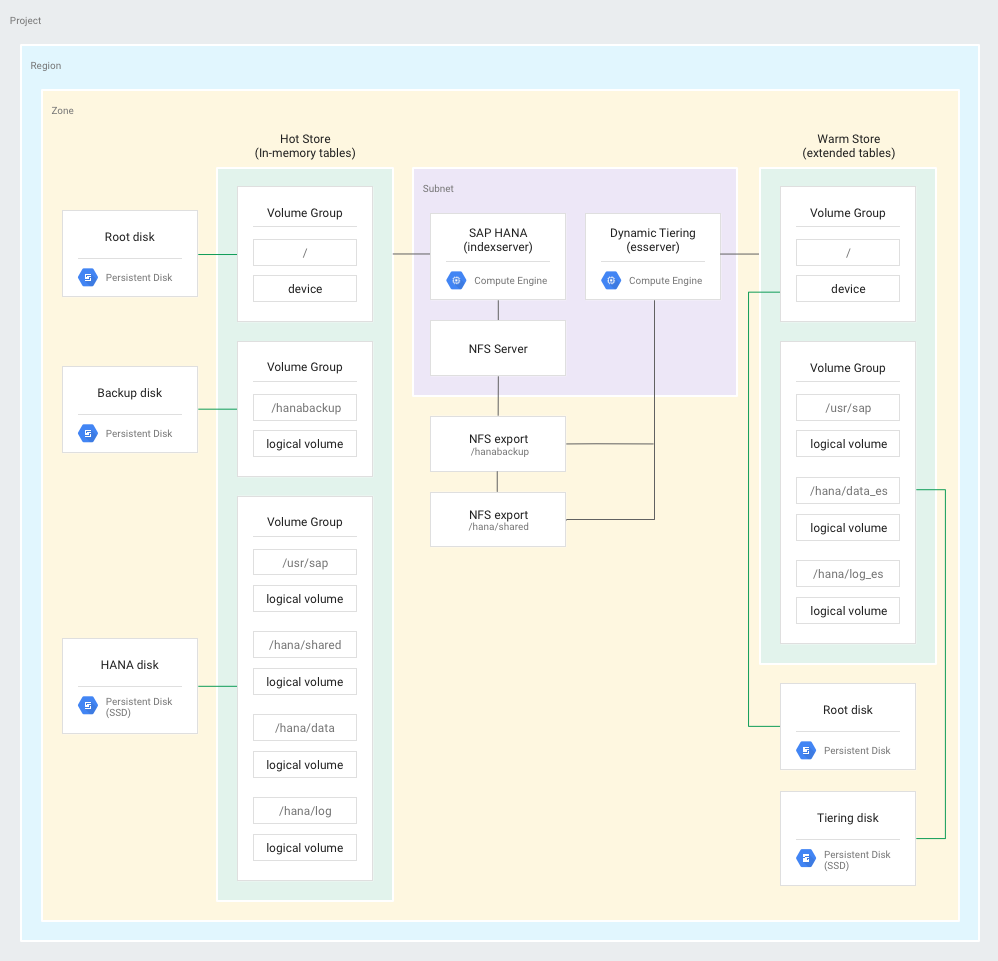SAP HANA Dynamic Tiering is approved by SAP to run on Google Cloud.
About SAP HANA dynamic tiering on Google Cloud
SAP HANA dynamic tiering provides disk-based, large-volume extended storage for your SAP HANA warm data.
The storage is provided by Compute Engine SSD persistent disks that are attached to the SAP HANA dynamic tiering VM.
For more information from SAP about SAP HANA Dynamic Tiering and its support on Google Cloud, see the following SAP Notes:
- 2555629 - SAP HANA 2.0 Dynamic Tiering – Hypervisor and Cloud Support
- 2456432 - SAP Applications on Google Cloud: Supported Products and Google Cloud machine types
Resource requirements
VM types
On Google Cloud, the SAP HANA dynamic tiering server must run on a dedicated Compute Engine virtual machine (VM). Running dynamic tiering on the same VM as SAP HANA is not supported.
SAP recommends specific Compute Engine high-memory VM types for SAP HANA dynamic tiering on Google Cloud. The recommended VM types offer a range of sizes to choose from that cover most use cases.
| Dynamic tiering data capacity | VM type | Memory |
|---|---|---|
| 512 GB | n1-highmem-8 |
52 GB |
| 1,300 GB | n1-highmem-16 |
104 GB |
| 5,000 GB | n1-highmem-32 |
208 GB |
| 10,000 GB | m1-megamem-96 |
1433 GB |
If, after deploying SAP HANA dynamic tiering on one of the recommended VM types, your monitoring indicates a need for more resources, you can switch to one of the larger recommended VM types.
If, after switching to one of the larger recommended VM types, your monitoring still indicates a problem, such as a performance bottleneck, SAP supports switching to a custom VM in which you adjust the vCPUs, memory, or both to meet your performance objectives.
For guidance on sizing resources for SAP HANA dynamic tiering, see the SAP HANA Dynamic Tiering documentation.
For more information about different VM instance types and their use cases, see machine types.
Storage configuration
Use a single SSD persistent disk for the SAP HANA dynamic tiering store and transaction logs. The minimum size for the disk is 550 GB.
Use LVM to partition the disk into three volumes for the /usr/sap,
/hana/data_es, and /hana/log_es directories. To size the volumes, follow the
guidance in the SAP HANA Dynamic Tiering documentation.
SAP Note 2140959
also contains information about sizing the dynamic tiering directories.
SAP HANA dynamic tiering shares the /hana/shared and /hanabackup
directories with SAP HANA, which must be on persistent disks that are
mounted on both the VMs for SAP HANA and the dynamic tiering server.
You may need to increase the size of the backup disk to accommodate the SAP HANA in-memory data and the data on disk. SAP HANA backs up both in the same backup operation.
Memory configuration
The memory allocations included with the recommended VM types for SAP HANA dynamic tiering are sufficient in most cases.
If your monitoring indicates that the recommended VM type you are using is causing a performance bottleneck, you can switch to a custom VM and adjust the vCPUs or memory to fix the problem.
For guidance on determining the amount of memory you need, see the SAP HANA Dynamic Tiering documentation.
Operating system selection
SAP HANA dynamic tiering must run on the same type and version of operating system as the SAP HANA system it supports.
For the operating systems that SAP certifies for SAP HANA on Google Cloud, see Certified operating systems for SAP HANA.
Pricing and quota considerations for SAP HANA dynamic tiering
You are responsible for the costs incurred by the resources you deploy by following this guide. Use the pricing calculator to help estimate your actual costs.
For pricing considerations for the base SAP HANA system, see the SAP HANA Planning Guide.
Quotas
Include the Google Cloud resources that SAP HANA dynamic tiering uses, such as vCPUs and persistent disks, when calculating your resource quotas for your SAP HANA system.
For quota requirements for the base SAP HANA system, see the SAP HANA Planning Guide.
You can view your current quotas in the Google Cloud console.
Licensing
Running SAP HANA dynamic tiering on Google Cloud requires you to bring your own SAP HANA dynamic tiering license (BYOL). SAP HANA dynamic tiering requires its own license, separate from the SAP HANA license.
A new installation of dynamic tiering includes a temporary license that is good for a period of time determined by SAP, typically 90 days. If a temporary license expires before a permanent license is installed, dynamic tiering ceases to function.
For more information about SAP licensing, see Dynamic Tiering Licensing.
Deployment architecture
SAP HANA dynamic tiering must be deployed on a dedicated VM in the same Compute Engine zone as the SAP HANA system it supports.
The following diagram shows a SAP HANA system on one Compute Engine VM instance and a dynamic tiering server on another. Both VM instances are in the same Virtual Private Cloud subnetwork and the same Compute Engine zone.
The /hana/shared and /hanabackup directories are stored on persistent disks
that are mounted directly to the VM for SAP HANA and mounted via NFS to the VM
for the dynamic tiering server. The dynamic tiering server uses a single
persistent disk that is partitioned into three volumes for the usr/sap,
/hana/data_es, and /hana/log_es directories.

